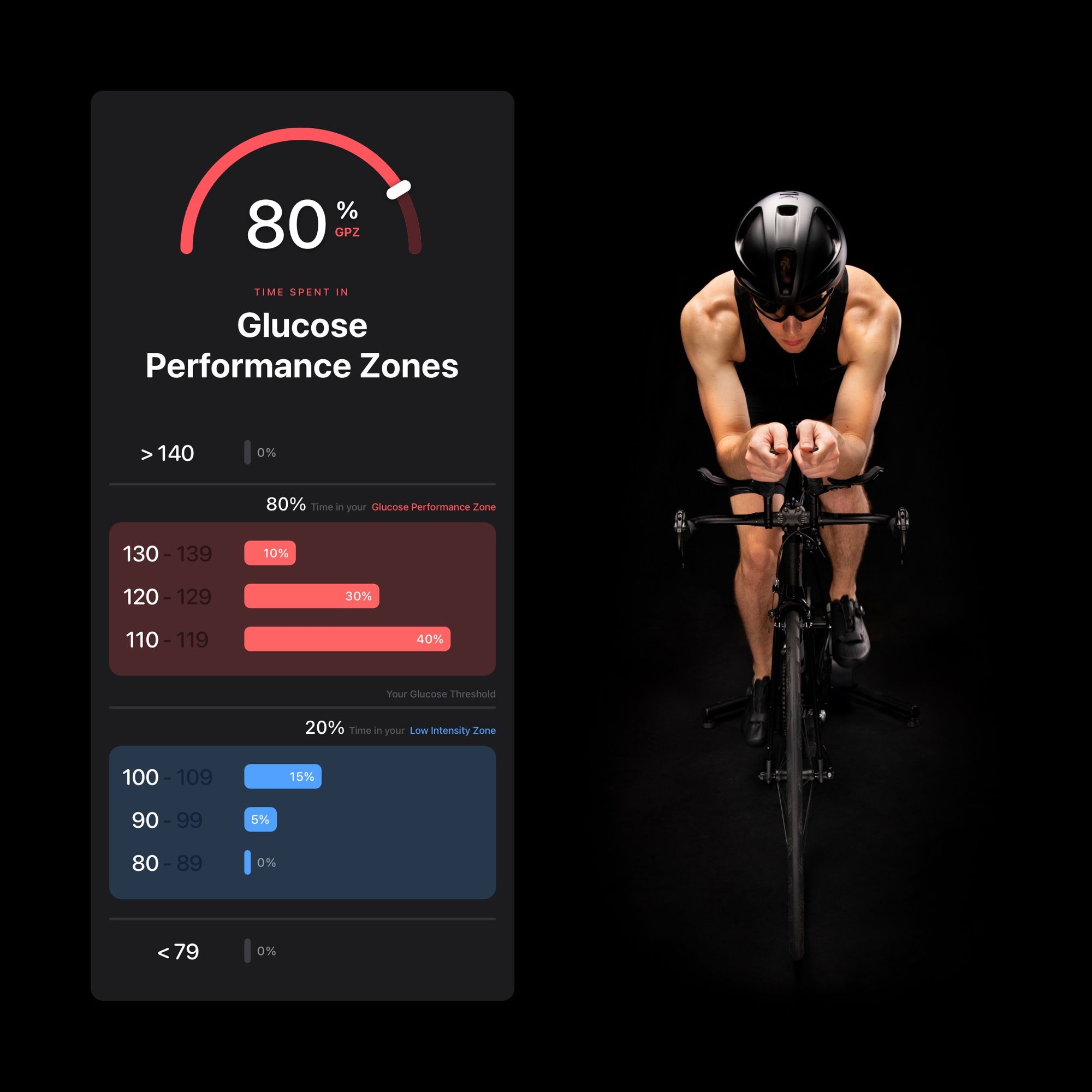High Intensity Glucose Performance Zone (GPZ) = Your optimal fuel range. How do we stay there? By supplying the right amount of glucose at the right times during high-intensity demands.
We think about maximizing athletic performance in two categories: On-Hours and Off-Hours.
On-Hours = training or performance. Off-Hours = recovery and preparation.
In this article, we'll discuss:
- How does my body use fuel to perform?
- What are Glucose Performance Zones?
- How can I experiment to dial in my Glucose Performance Zones?
How does my body use fuel to perform?
Fact: Humans burn a combination of carbohydrate and fat-based fuels to provide energy. During high intensity workouts, we burn more carb-based sources. During those long slow burns, we can rely more heavily on fat stores.
We all know you can achieve specific performance gains training around your threshold. So let’s focus on that high intense exercise: Carbohydrates are the chief exogenous energy source. They are key. The power generated solely by carb breakdown is double that achieved with fat. So guess what you want to fuel up on during intense aerobic activities? Right, you don’t need to guess. It’s carbs – the quick-supply energy source made for high rates of cellular work. In simple terms, it’s the fuel source that makes your body able to go faster, longer.
Time for some data:
During the transition from sitting to walking, energy transfer increases about 4 times.
From walking to sprinting all-out, the rate of energy transfer increases about 120 times almost immediately. To meet your body’s energy demands as you increase the intensity and duration of your workout, muscle glucose uptake can increase by 30-50 times.
In other words: Maintaining a constant glucose flux to the muscle will win you a lot of stamina. And elevating your glucose levels will help sustain the glucose transport from your intestine to the working muscle. Remember: carbohydrates breakdown to glucose.
On average, intense aerobic exercise (that’s anything more than 15 kcal/min, >60% of your max power, or >85% of your maximal heart rate) derives 80% of its energy requirement from carbohydrates. This means that about 4g of carbohydrates are metabolized per minute (1g of carbohydrates = 4 kcal). This energy demand means roughly 240 grams per hour of carbs are required (even if your maximum carbohydrate intake can peak around 100 grams per hour).
The main finding here is the importance for pre-exercise glucose loading and in-exercise glucose feeding strategies to ensure that you supply your body with the optimal amount of glucose to sustain your desired performance level throughout your session. A big scientific “Yes!” for glucose and glucose loading.
We call this optimal fuel range your high intensity Glucose Performance Zone. In-training, maintaining these glucose levels = sustaining your threshold intensity level = maximizing performance gains and adaptations.
So now we know that sustaining your Glucose Performance Zone is a key factor to maximize your training. To maintain your GPZ, you have to fuel adequately in those 24 to 48 hours leading up to your exercise event, as well as planning to consume adequate fuel during your exercise to maintain your levels.
It’s almost like glucose management is half the strategy for optimal performance, right? At least now you have a way to monitor it.
Which brings us to: Time to test this for yourself.
How can I experiment to dial in my Glucose Performance Zones?
We designed this experiment to help you determine your own unique Glucose Performance Zone. Ready? Let’s go.
1. Perform 5-7 high-intensity exercises of similar intensity and duration. Create Exercise Events for each.
- Add Details to describe your workout
- Set your Perceived Effort and Feel
- Tag these Exercise Events with #FindMyGPZ
2. Select an Exercise Event where you felt particularly good. Use the compare feature to choose another Event to compare with. Analyze your glucose levels, your performance, and how you felt across different Events.
3. While analyzing your data, ask the following questions:
- At what points in time did I feel the best? Where was I dragging?
- When was my pace the strongest?
- Which time periods did I sustain that pace?
- When did my performance start to degrade?
- What were my glucose levels during all of those times?
4. Open Settings and update your Glucose Performance Zone. Use the glucose range that works best for you to sustain your desired level of performance.
5. Repeat steps 1 through 4 once every few months. Your GPZ may change along with your fitness levels. It’s important to reset often.
6. Experiment often. Try various glucose loading, in-exercise fueling (timing and quantity), and recovery fueling strategies that help you to best maintain your GPZ during intense training sessions.
7. Share your learnings. What breakthroughs are you finding? What strategies are emerging? Bring it to the Supersapiens Athletes Facebook group so we can push each other.
Find out your optimal fuel range. Then report back to us on your learnings!
References
- Van Loon, L. J., et.al. The effects of increasing exercise intensity on muscle fuel utilisation in humans. J Physiol, 536, 295-304, 2001.
- Bergström, J., et.al.. Diet, muscle glycogen and physical performance. Acta physiologica scandinavica, 71, 140-150, 1967.
- O'brien, M. J..Carbohydrate dependence during marathon running. Med Sci Sports Exerc, 25, 1009-17, 1993.
